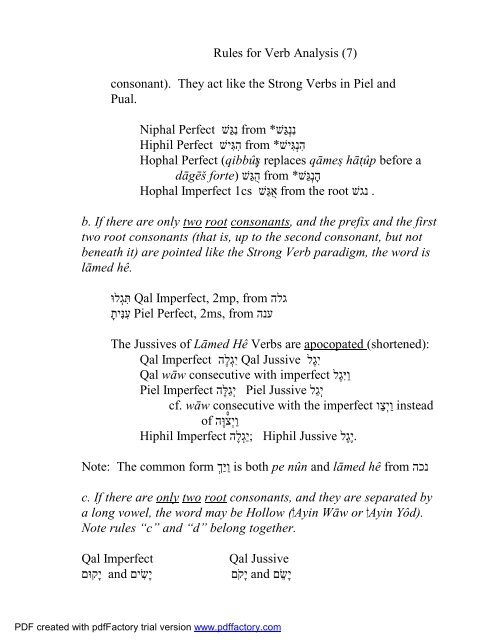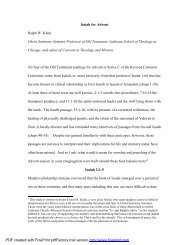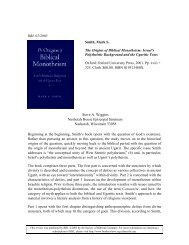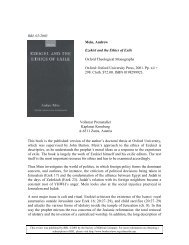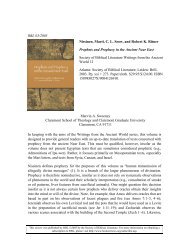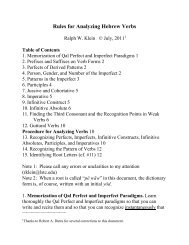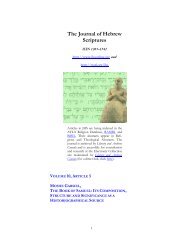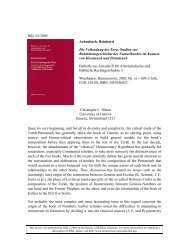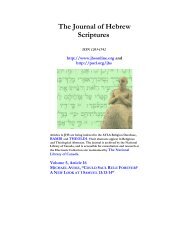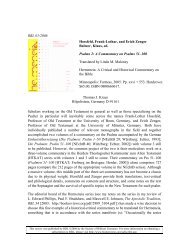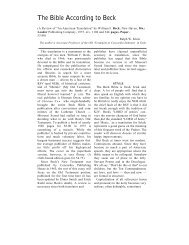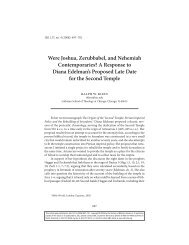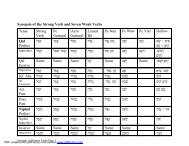Rules for Analyzing Hebrew Verbs
Rules for Analyzing Hebrew Verbs
Rules for Analyzing Hebrew Verbs
You also want an ePaper? Increase the reach of your titles
YUMPU automatically turns print PDFs into web optimized ePapers that Google loves.
<strong>Rules</strong> <strong>for</strong> Verb Analysis (7)<br />
consonant). They act like the Strong <strong>Verbs</strong> in Piel and<br />
Pual.<br />
Niphal Perfect שׁגַּנִ from *שׁגַּנְנִ<br />
Hiphil Perfect שׁיגִּהִ from *שׁיגִּנְהִ<br />
Hophal Perfect (qibbûsD. replaces qāmes. hāt.ûp be<strong>for</strong>e a<br />
dāgēš <strong>for</strong>te) שׁגַּהֻ from *שׁגַּנְהָ<br />
Hophal Imperfect 1cs שׁגַּאֻ from the root שׁגנ .<br />
b. If there are only two root consonants, and the prefix and the first<br />
two root consonants (that is, up to the second consonant, but not<br />
beneath it) are pointed like the Strong Verb paradigm, the word is<br />
lāmed hê.<br />
וּלגְתִּ Qal Imperfect, 2mp, from הלג<br />
תָינִּעִ Piel Perfect, 2ms, from הנע<br />
The Jussives of Lāmed Hê <strong>Verbs</strong> are apocopated (shortened):<br />
Qal Imperfect הלֶגְיִ Qal Jussive לגֶיִ<br />
Qal wāw consecutive with imperfect לגֶיִּוַ<br />
Piel Imperfect הלֶּגַיְ Piel Jussive לגַיְ<br />
cf. wāw consecutive with the imperfect וצַיְוַ instead<br />
of הוֶּציְוַ<br />
Hiphil Imperfect הלֶגְיַ; Hiphil Jussive לגֶיֶ.<br />
Note: The common <strong>for</strong>m ךְיַּוַ is both pe nûn and lāmed hê from הכנ<br />
c. If there are only two root consonants, and they are separated by<br />
a long vowel, the word may be Hollow ( Ayin Wāw or Ayin Yôd).<br />
Note rules “c” and “d” belong together.<br />
Qal Imperfect Qal Jussive<br />
םוּקיָ and םישִׂיָ םקֹיָ and םשֵׂיָ<br />
PDF created with pdfFactory trial version www.pdffactory.com


